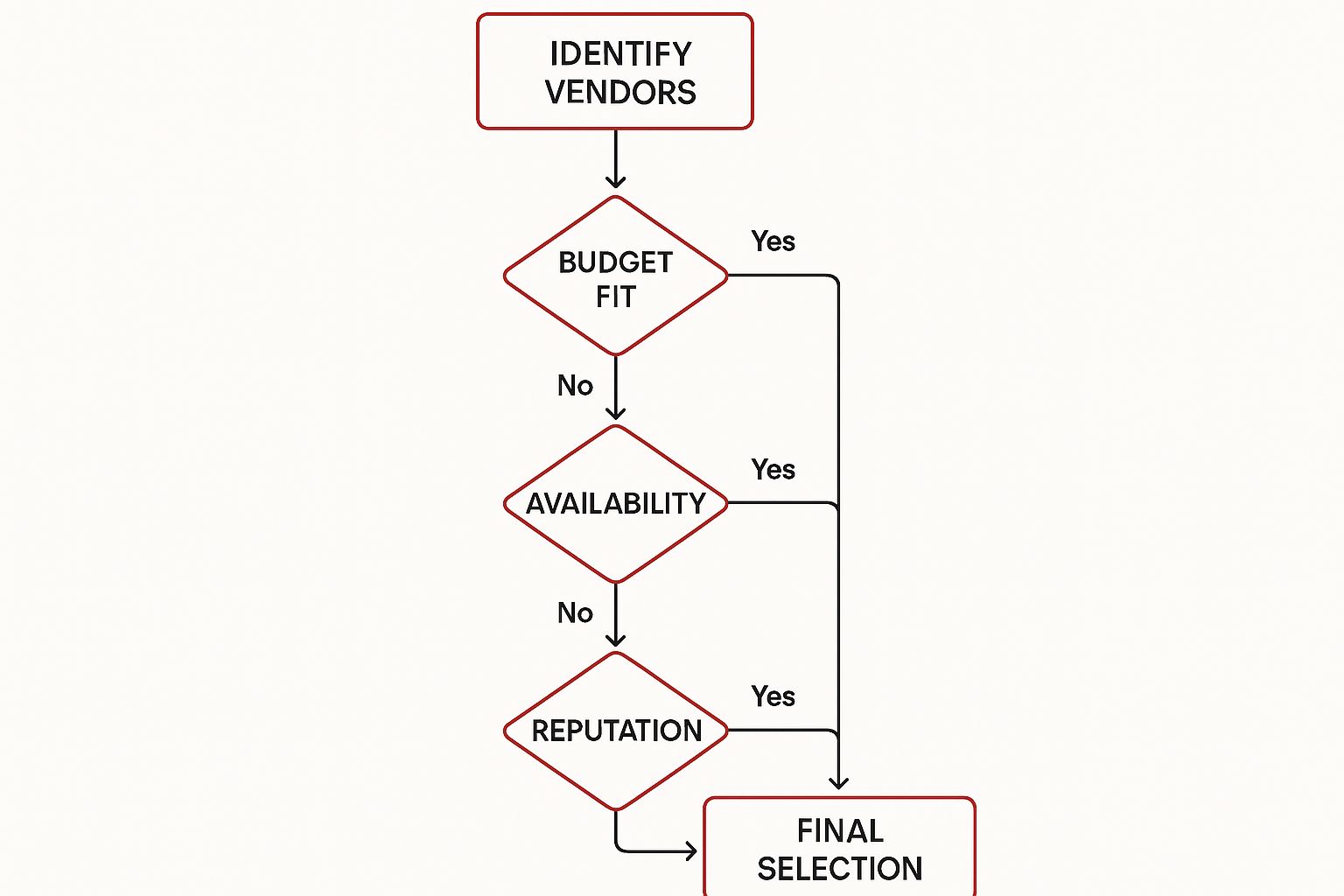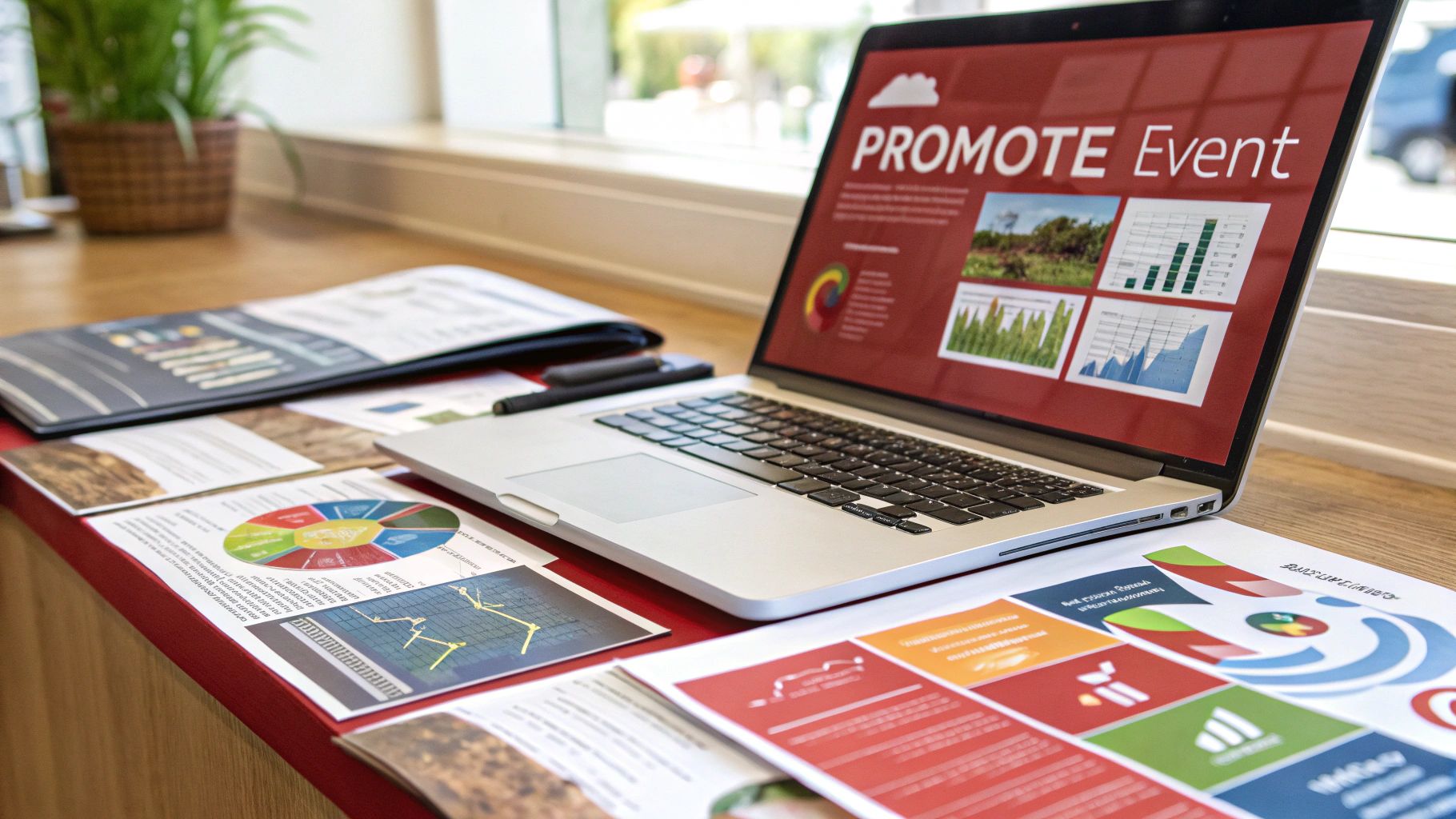The Evolution of Business Event Planning

The old image of stiff conference rooms and predictable presentations is rapidly disappearing. Business event planning has become much more sophisticated, going beyond basic logistics to become a key strategy for achieving business goals.
This change is driven by a greater understanding of how events can create meaningful connections with audiences. Organizations are now using a broader range of event formats and technologies to make these experiences more engaging and productive.
From Traditional to Transformative: Embracing New Formats
While traditional in-person events still hold significant importance for building relationships and networking, virtual and hybrid formats offer compelling alternatives. These formats offer greater accessibility and cost-effectiveness, expanding reach to audiences regardless of location.
Hybrid events, in particular, combine the advantages of both in-person and online experiences. This allows businesses to meet diverse preferences and maximize their impact. This evolution marks a significant shift in how companies approach event planning.
The increasing popularity of virtual and hybrid events is clear in the industry's growth. The global virtual events market has experienced significant expansion, growing from $193.45 billion in 2024 to an impressive $236.69 billion in 2025.
This remarkable growth is driven by the adoption of hybrid and virtual event models, with almost 74.5% of event planners now incorporating hybrid formats. This effectively integrates both in-person and online audiences. For a closer look at these statistics, visit Cvent.
Technology's Role in Modern Event Planning
Technology plays a vital role in this ongoing evolution. From comprehensive event planning software to interactive mobile apps and virtual reality experiences, technology is reshaping how businesses plan, execute, and measure the success of their events.
Choosing the right technology is essential. The focus should be on tools that truly enhance the event experience and support business objectives, avoiding unnecessary complications. This requires careful consideration of which technologies best suit specific needs and audience preferences.
The Future of Business Event Planning
The future of business event planning will likely feature even greater personalization and data-driven decisions. As technology continues to advance, businesses will gain access to more sophisticated tools for analyzing audience behavior and customizing events to individual preferences.
This focus will lead to more engaging, impactful, and successful events. By adapting to these advancements, businesses can ensure their events stay relevant, effective, and aligned with their evolving strategic goals.
Creating Strategic Objectives That Actually Matter
Stop planning events just to fill the calendar. Instead, concentrate on creating events that produce real, tangible results. This means developing clear, measurable objectives tied directly to positive business outcomes. Shift the focus from simply hosting an event to strategically aligning it with broader company goals. This section explores the framework for creating purpose-driven events that deliver measurable results, moving beyond simple attendance counts.
Identifying Key Stakeholders and Their Needs
The first step in planning any successful business event is identifying your key stakeholders. This goes beyond simply listening to what they say they want. You need to understand what they actually need to achieve their objectives.
For example, a sales team might request a large conference to generate leads. However, their core need might be to cultivate relationships with existing clients. Understanding this crucial distinction allows for more targeted and effective event planning. This might mean a smaller, more focused gathering is more effective than a large, impersonal conference.
Establishing SMART Goals
Once stakeholder needs are clearly identified, the next step is establishing SMART goals. These are goals that are Specific, Measurable, Achievable, Relevant, and Time-bound.
For example, instead of a vague goal like "increased brand awareness," a SMART goal might be to "generate 100 qualified leads within three months of the event." This provides a concrete, measurable target you can track and evaluate, ensuring the event contributes directly to your overall business success.
Measuring True Impact: Meaningful Metrics
Choosing the right metrics is essential for measuring the true impact of your event. Go beyond basic metrics like attendance and satisfaction surveys. Focus on metrics that demonstrate genuine business value, such as pipeline influence, revenue attribution, relationship development, and thought leadership positioning. For instance, tracking the number of deals closed that originated from event leads clearly demonstrates ROI. These detailed metrics provide valuable insights into event effectiveness.
To help illustrate the connection between event types and their strategic objectives, let's take a look at the following table:
Types of Business Events and Their Strategic Objectives
A comparison of different business event types and their primary strategic goals
| Event Type | Primary Objectives | Key Success Metrics | Typical ROI Expectations |
|---|---|---|---|
| Product Launch | Generate excitement and awareness for a new product, drive pre-orders/sales | Media mentions, social media engagement, pre-order/sales numbers | Varies greatly by product and market |
| Customer Appreciation Event | Strengthen client relationships, foster loyalty | Customer satisfaction scores, repeat business rates | Difficult to quantify directly, but fosters long-term loyalty |
| Industry Conference | Position company as a thought leader, generate leads, network with potential partners | Number of leads generated, media coverage, partnership opportunities | Measured by leads, partnerships, and brand awareness |
| Internal Training Seminar | Improve employee skills and knowledge, boost team morale | Employee performance metrics, internal surveys | Increased productivity and employee retention |
This table summarizes the various objectives and metrics associated with different types of business events. As you can see, choosing the right metrics is crucial for demonstrating the value of your events.
Practical Tools for Strategic Event Planning
Transforming vague aspirations into specific, measurable targets strengthens your position with leadership and justifies event investments. Streamline this process by using practical tools like worksheets and templates. Worksheets guide you through defining objectives, identifying stakeholders, and setting SMART goals. Templates provide pre-built measurement frameworks tailored to specific business objectives. These tools empower you to present a compelling business case that links every dollar spent to the expected ROI. They also help ensure your event planning process is strategic, efficient, and results-oriented, allowing you to create events that deliver real business value.
Budgeting for Impact, Not Just Expenses

Creating a memorable business event involves more than just keeping costs down; it requires strategic budget allocation. This section focuses on maximizing impact without breaking the bank. Think of your budget like an investment: allocate wisely for the best returns. Understanding where each dollar goes and how it contributes to your overall event objectives is crucial.
Allocating Resources for Maximum Impact
Successful event planning hinges on understanding how to distribute resources effectively. If knowledge sharing is your primary goal, prioritize investing in engaging, high-quality speakers. If networking is key, a premium venue might be a better investment. This ensures your spending aligns with your goals.
To manage costs, consider using an event budget template. This helps categorize expenses and track spending. Breaking down your budget into categories – venue, catering, technology, marketing, and contingency – provides a clear overview. This detailed approach prevents overspending and allows for better control.
Avoiding Common Budget Pitfalls
Even seasoned planners can encounter budget pitfalls. Underestimating hidden costs is a common mistake. Unexpected expenses like Wi-Fi charges, permits, or transportation can add up quickly. Another pitfall is neglecting a contingency fund. Unexpected issues can arise, so a financial buffer is essential.
Negotiating with vendors is another area where savings can be found. Don't hesitate to ask for discounts or explore alternative options. Partnering with local businesses for catering or sponsorships can significantly reduce costs while also supporting the community.
Building a Compelling Business Case
Securing budget approval requires a strong business case. Connect every expense to anticipated outcomes. If your goal is lead generation, demonstrate how the event will attract potential customers and create new business opportunities. This direct link between spending and expected ROI strengthens your budget proposal. Showcasing the potential return, like increased sales or brand awareness, further emphasizes the event's value.
The business event planning sector is thriving, with projections showing significant growth for 2025. Research suggests that 66% of event planners expect to organize more events in 2025 compared to 41% the previous year. Budgets are also on the rise, with 74% of event marketers anticipating increased funding. Find more detailed statistics here. This positive trend highlights the importance of strategic event planning and budgeting. Learn more in our article about Top 10 Giveaways for Conferences to Boost Your Brand. Careful planning and budgeting help businesses maximize the impact of their events and achieve their strategic objectives.
Choosing Your Format: Finding the Perfect Fit
The decision between an in-person, virtual, or hybrid event format is crucial for business event planning. It impacts your event's effectiveness and how well it meets your objectives. This section explores how factors like audience demographics, content complexity, engagement goals, and budget influence your format selection.
Leveraging the Strengths of Each Format
Each format offers unique advantages. In-person events excel at fostering strong relationships and networking opportunities. Face-to-face interaction creates a sense of connection that's difficult to replicate virtually. This format is ideal for relationship building and community focused events.
Virtual events offer a data-rich environment, tracking attendee engagement and preferences. This data helps analyze event effectiveness and refine future strategies. Plus, virtual events often have lower costs and broader accessibility for a geographically dispersed audience.
Hybrid events combine the best of both worlds. They expand your reach with a virtual component while retaining the personal touch of in-person interactions. This format caters to diverse audience preferences and maximizes overall event impact.
Guiding Your Decision: A Practical Framework
Several factors influence the optimal format. Consider your target audience. Are they local or spread across different regions? Think about your content. Is it highly interactive or primarily informational? Evaluate your budget. Can you afford a large-scale in-person event, or is a virtual format more feasible? Your engagement goals are also key. Do you want deep networking or broad awareness?
You might be interested in: 10 Event Giveaway Ideas to Wow Your Audience. Giveaways can boost engagement and leave a lasting impression, regardless of the format.
The infographic below visualizes a decision-making process, adaptable to choosing your event format. By systematically considering key factors, you can choose the format that best suits your business event.

To further aid your decision-making, let's examine a comparison of different event formats. The table below outlines the advantages, challenges, and ideal applications of each.
Introduction to Event Format Comparison Table: This table provides a concise overview of various event formats to assist in selecting the most suitable option for your business needs.
| Format | Key Advantages | Potential Challenges | Best For | Cost Considerations |
|---|---|---|---|---|
| In-Person | Strong networking, relationship building, high engagement | Limited reach, logistical complexity, higher costs | Product launches, team building, executive retreats | Venue, catering, travel |
| Virtual | Broad reach, cost-effective, data-rich insights | Lower engagement, technical issues, requires strong virtual platform | Webinars, conferences, training sessions | Platform fees, marketing |
| Hybrid | Combines in-person and virtual benefits, wider audience engagement, flexible options | Requires careful planning and coordination, technical expertise, potential for unequal experiences | Large conferences, international events, product demos | Combination of in-person and virtual costs |
Key Insights from the Table: As you can see, each format presents a unique set of trade-offs. In-person events prioritize connection, virtual events prioritize reach and data, and hybrid events strive for a balance of both.
Aligning Your Format with Business Goals
Effective event planning hinges on aligning your chosen format with your overall business goals. Whether it's driving sales, fostering client relationships, or increasing brand awareness, your event format should support these objectives. Understanding your goals is crucial for choosing the right format and maximizing event impact, ultimately contributing to your business success.
Technology That Enhances, Not Complicates

Technology plays a vital role in the success of any business event. Choosing the right tools can elevate the entire experience. However, the key is to select technology that simplifies, not complicates, the planning process. This section explores the essential technologies that can transform ordinary business events into truly memorable and impactful experiences. We'll focus on practical applications and ease of use.
Essential Tech Tools for Business Events
The right tech stack can significantly improve every stage of business event planning. Registration platforms, like Eventbrite, streamline the signup process. These tools make it easy for attendees to register and provide organizers with valuable data. Mobile apps offer a centralized hub of information, giving attendees access to schedules, speaker bios, interactive maps, and networking opportunities.
Engagement tools boost interaction and create a more dynamic event. Features like live polls, Q&A platforms, and social media integrations encourage active participation and foster a sense of community. Finally, analytics solutions offer valuable insights into event performance, measuring attendance, engagement levels, and overall ROI. Data-driven analysis helps refine future events and demonstrate their business value.
Practical Approaches for Technology Selection
Choosing the right technology depends on various factors, including your event goals, audience preferences, and budget. A small workshop might only need a simple registration platform and a basic mobile app. A larger conference may require a more comprehensive suite of tools. The key is to select tools that align with your objectives and integrate seamlessly.
If networking is a primary goal, consider platforms with dedicated networking features. If attendee engagement is paramount, explore interactive tools such as live polls and Q&A platforms. Evaluate each tool's features and functionality to ensure it meets your needs and enhances the overall experience without adding unnecessary complexity. For additional guidance on planning successful events, check out this helpful resource: Virtual Event Checklist: Your Ultimate Planning Guide.
Implementation Strategies to Prevent Tech Disasters
Effective implementation is just as crucial as selecting the right technology. Thorough testing and training are essential for success. Conduct trial runs of all technologies before the event to identify and resolve any issues. Train your team and volunteers on how to use the chosen platforms effectively.
Having technical support available during the event is crucial. Develop a well-defined technical plan that includes details about all technologies used, contact information for technical support, and contingency plans for technical difficulties. Preparation is the key to minimizing technical problems and ensuring a smooth and enjoyable event. By thoughtfully selecting and implementing the right technologies, you can create a seamless and engaging experience that achieves your business objectives.
Measuring What Matters: Beyond Basic Metrics
Attendance numbers and satisfaction surveys are good starting points for measuring event success. However, they only provide a surface-level view. Savvy businesses are looking beyond these vanity metrics and focusing on outcomes that have a direct impact on their bottom line. This includes factors like pipeline influence, revenue attribution, relationship development, and establishing thought leadership. This section explores how leading organizations measure the true impact and ROI of their events through practical, data-driven approaches.
Collecting Actionable Information: Before, During, and After
Gathering the right data requires a strategic approach across all event stages. Before the event, pre-event surveys can help understand attendee expectations and tailor the content accordingly. During the event, tools like live polls and Q&A sessions can offer immediate feedback on attendee engagement.
After the event, post-event surveys help assess satisfaction and gather valuable insights for future events. However, keep surveys short, focused, and incentivized to combat survey fatigue and maximize participation.
Attributing Business Outcomes to Event Participation
Connecting event activities to tangible business results is key to demonstrating ROI. This might involve tracking leads generated, deals closed, partnerships formed, and brand awareness growth.
Implementing a system for lead capture and follow-up is crucial. Using CRM software to track leads from initial contact at the event to conversion provides direct attribution, demonstrating how events contribute to the sales pipeline and overall revenue.
For further reading, check out Measuring Brand Awareness: Proven Tactics. Effective facilitation is key for virtual events and remote workshops. Learn more about this in Facilitating Remote Workshops.
Crafting Compelling ROI Reports
Once data is collected and analyzed, presenting it effectively to leadership is essential. A compelling ROI report should clearly show the event's contribution to business objectives.
Visualizations such as charts and graphs are helpful to present data concisely. Highlight key successes, such as the number of qualified leads generated or the rise in brand mentions on social media. Whenever possible, quantify the event's impact. For example, if the event led to new partnerships, estimate the potential revenue from those partnerships.
Building a Measurement Framework
A well-defined measurement framework ensures you're tracking the right metrics and collecting relevant data. This framework should align with your overall business objectives and be tailored to each event’s goals.
Start by identifying key objectives. Then, decide which metrics will best measure progress toward these objectives. Finally, outline the data collection methods you will use. This structure ensures focused and effective measurement efforts.
Tailoring Your Approach
Whether it's a small executive gathering or a large-scale conference, your measurement approach should be tailored to the event. For smaller events, concentrate on building relationships and collecting qualitative feedback. For larger events, use technology for large-scale data collection.
This adaptability ensures your measurement strategy aligns with the event's purpose and provides actionable insights. By using a data-driven approach, you can demonstrate the true value of your events and secure future investment. Ready to enhance your brand with impactful corporate gifts and promotional electronics? Explore the possibilities with Electronic Finishing Solutions for your next event.



